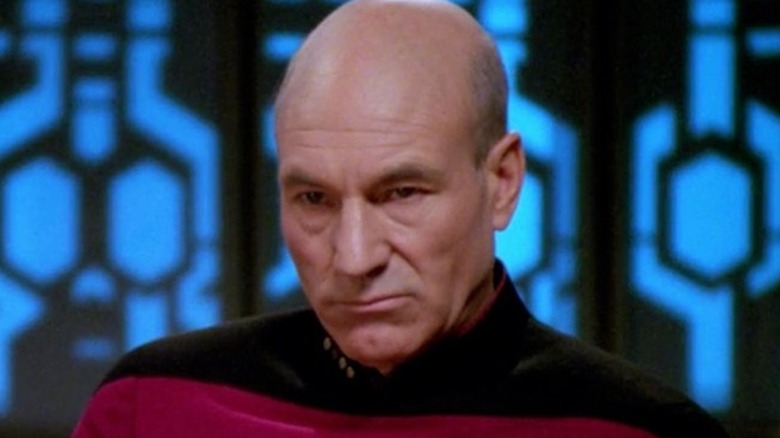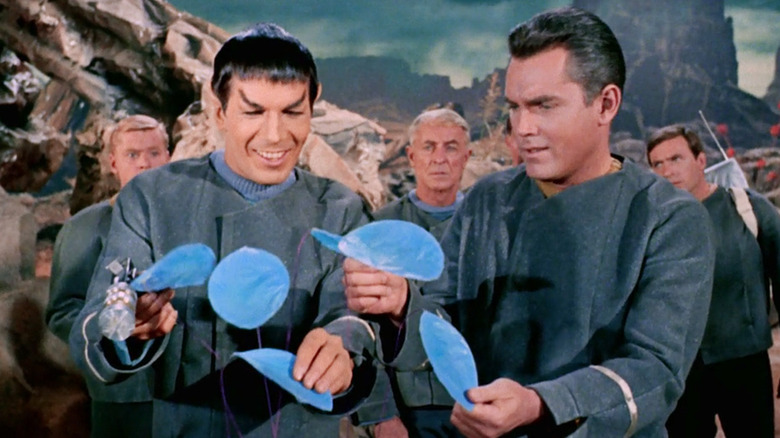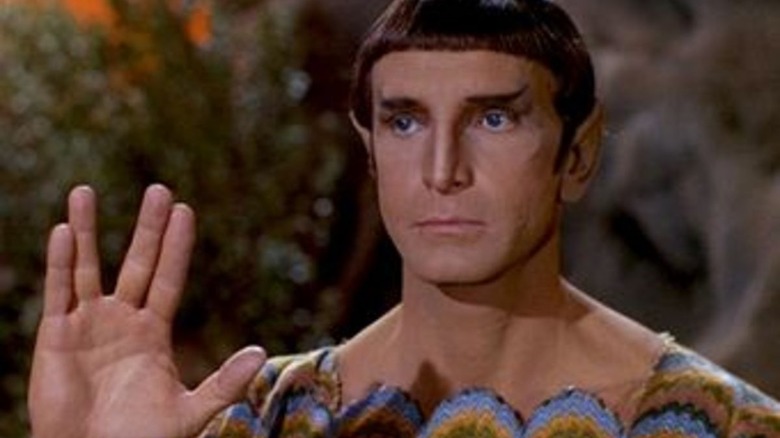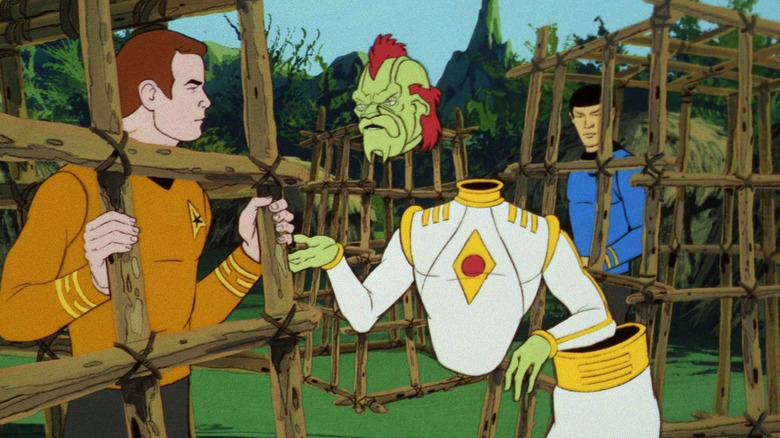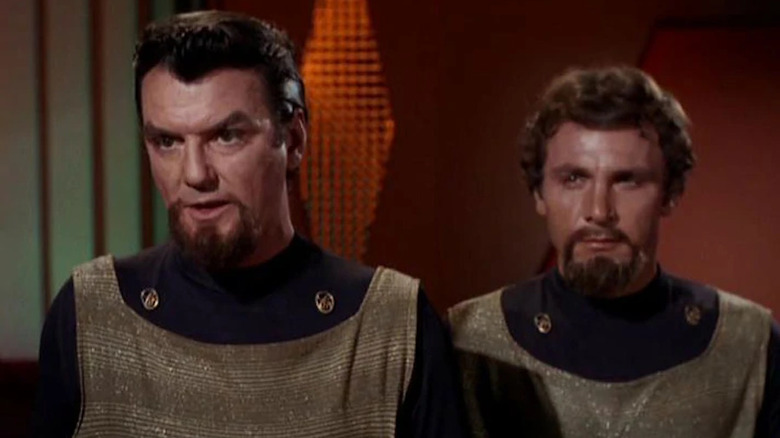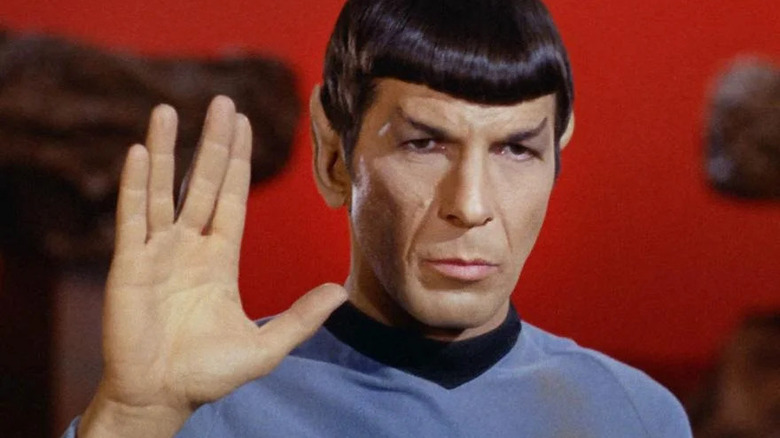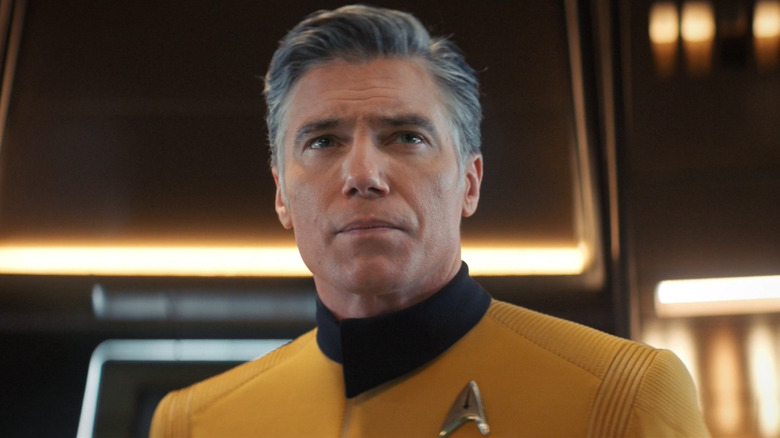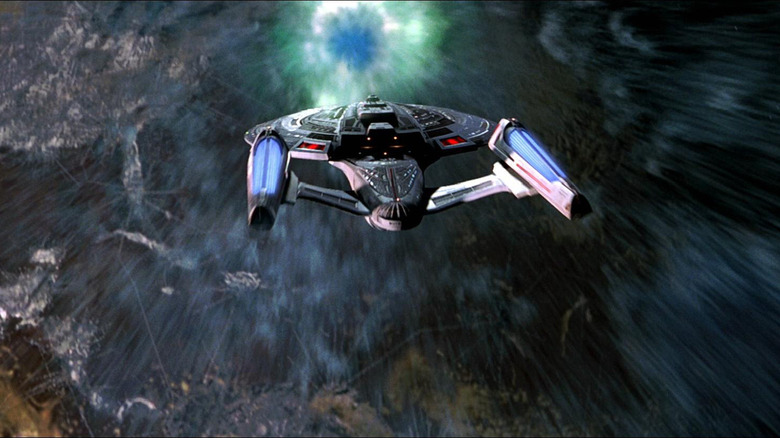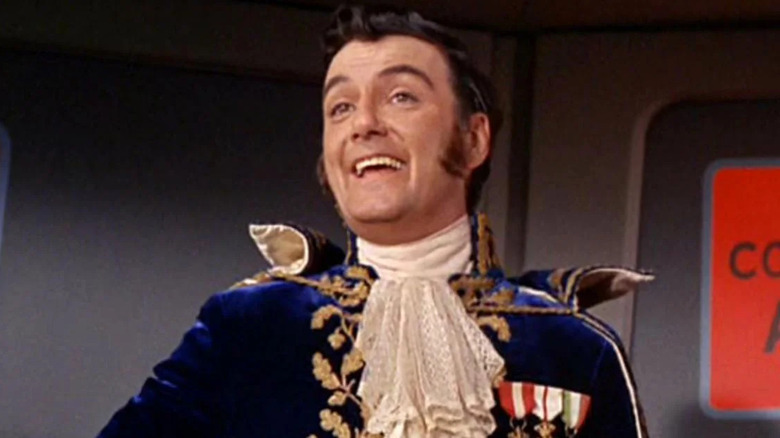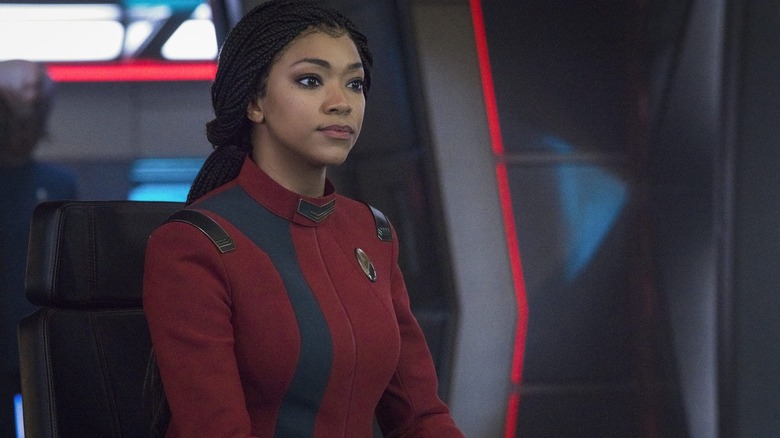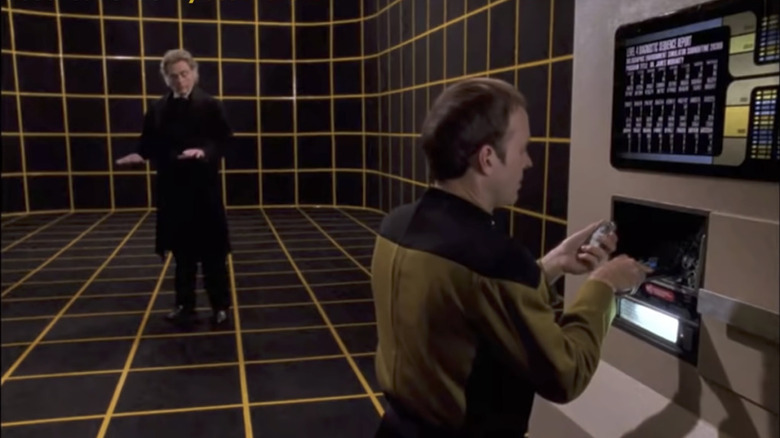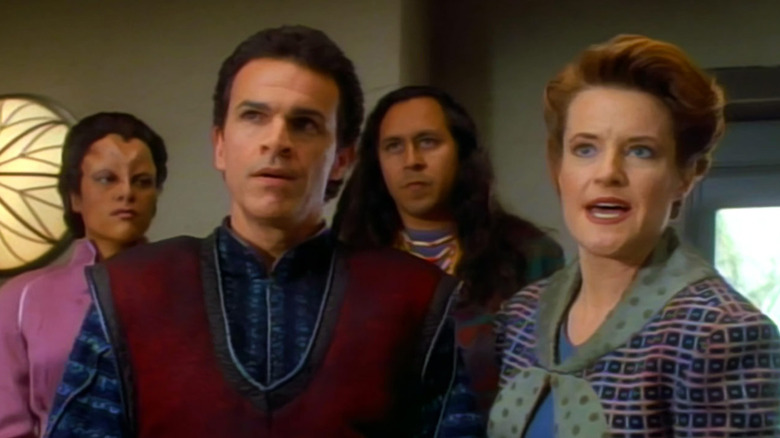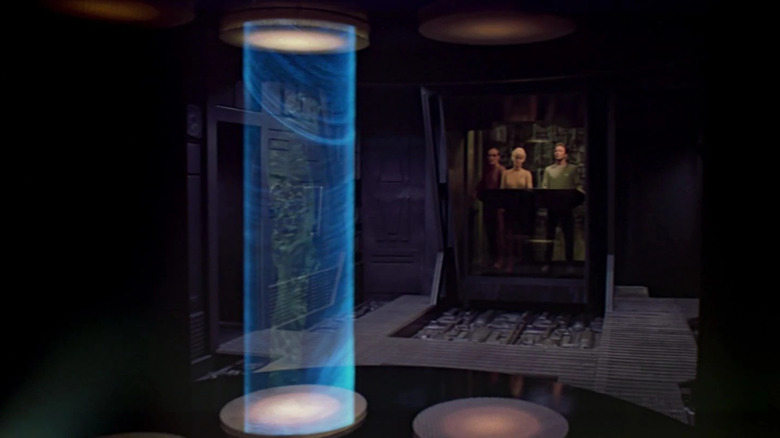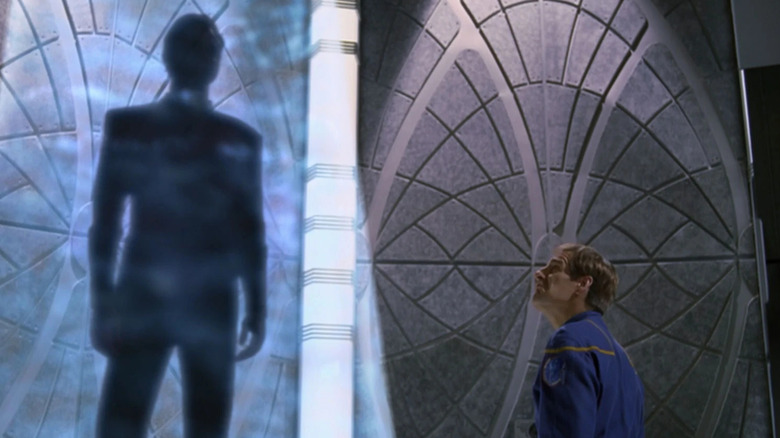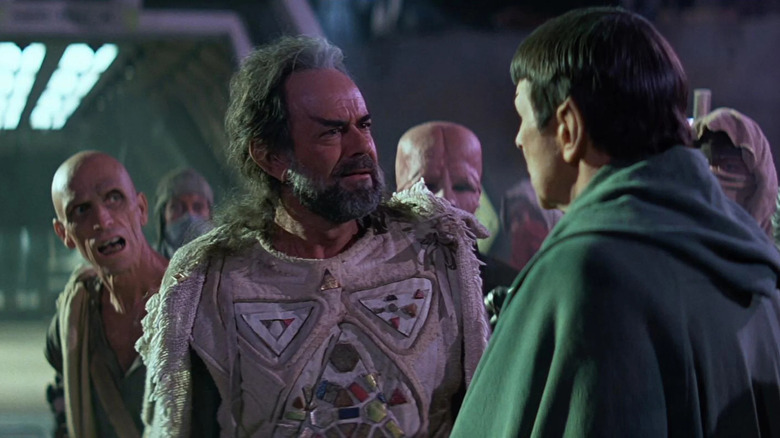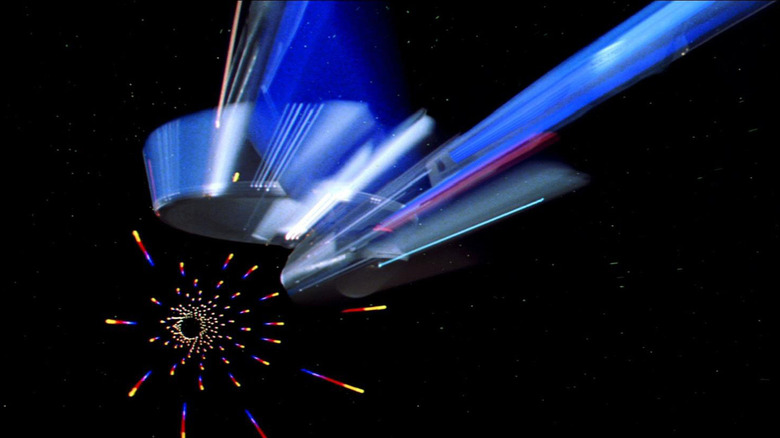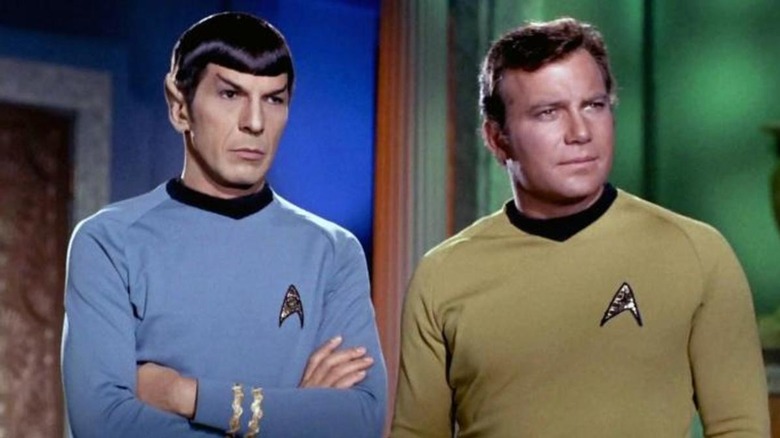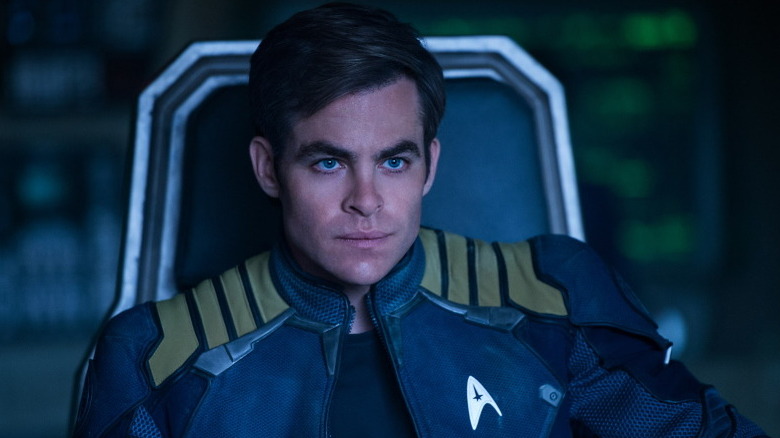The Most Difficult Star Trek Questions Finally Answered
Created by Gene Roddenberry as a western in space, the groundbreaking "Star Trek" series launched in 1966, and sparked one of the first global science fiction media franchises the world has ever known. After running for three seasons on NBC, the lights went dark in 1969, but not even cancellation could stop it. Revived in 1976 for a short-lived cartoon, it came back full throttle in 1979 with the first of six feature films starring the original cast.
The television revival of the '80s and '90s brought four new series to television, and four more big-screen outings. By the mid-2000s, another cancellation and a corporate split could have ended "Star Trek" for good, but once again like a phoenix it rose from the ashes with three blockbuster movies from producer and director J.J. Abrams. We're now in a new golden age of "Star Trek," with several new shows on streaming platform Paramount+.
With such a long and complicated history, there's any number of complex issues and topics that fans and pundits have mused about for decades. Whether it's a legal conundrum, an unresolved historical footnote, or a canon mystery, we're here to settle them once and for all, or as best as we can. These are the most puzzling "Star Trek" questions, finally answered.
Was The Cage ever aired on television?
The 1966 pilot episode of "Star Trek," titled "Where No Man Has Gone Before," wasn't actually the first episode filmed for the series — two years before, another pilot called "The Cage" was filmed, sporting a number of differences to the final aired pilot, including an entirely different captain. Instead of James T. Kirk it was Christopher Pike manning the captain's chair — the same Pike who would much later lead "Star Trek: Strange New Worlds."
The studio didn't like the first pilot and commissioned a second with a number of changes, including a new captain and first officer. After the second pilot debuted, the studio clearly didn't want to waste the footage from "The Cage," so it was cut up and used as flashbacks in the two-part episode "The Menagerie." In the years prior to home video, this could have led many to believe they had watched "The Cage" on television in the 1960s.
Decades later, in celebration of the franchise's 20th anniversary in 1986, "The Cage" was released on VHS and laserdisc, reassembled using a mix of scenes from "The Menagerie" and a B&W print owned by Gene Roddenberry. Just a year later a film archivist found the original 35mm color negatives, and in 1988 as part of a primetime special, "The Cage" finally aired on TV.
Why don't Vulcans have emotions?
It's well known that Vulcans are seemingly emotionless beings, guided by a strict sense of logic. But that's not quite true: they have all the same emotions as any human, they've just chosen to suppress them. We've seen emotional Vulcans a number of times in "Star Trek," usually when their logic fails them due to an outside influence or illness, or during the seven-year mating cycle known as Pon-Farr.
In the original "Star Trek" episode "This Side Of Paradise," Spock inhales the spores of an alien flower and is overcome with strong feelings of love; in the "Next Generation" episode "Sarek," the Vulcan illness called Bendii syndrome causes a breakdown of Sarek's emotional control. In the "Voyager" episode "Blood Fever," the Vulcan ensign Vorik becomes rageful during his Pon-Farr when unable to take a Vulcan mate. "Star Trek: Enterprise," meanwhile, suggested that living among humans can cause a Vulcan to be more emotional, because humans are a reminder of the way Vulcans used to be. Before the time of the Vulcan messiah Surak, founder of Vulcan logic, Vulcans were a warlike people fueled by emotions.
But thanks to the teachings of Surak, Vulcans are now trained to repress feelings through strict mental discipline, and sometimes undergo a ritual called the Kolinahr, which purges the last remnants of emotions. That said, we have seen some Vulcans rebel against their culture's tradition, including a faction of Vulcans who embrace emotion in the "Enterprise" episode "Fusion," and even Tuvok, who fought against it in his youth.
Is the animated series officially canon?
Airing for two seasons, "Star Trek: The Animated Series" continued the adventures of the starship Enterprise. Nearly the entire cast of the original series reprised their roles, and for fans in the 1970s it was enough to satiate their hunger for new "Star Trek."
Thanks to animation, the stories were able to envision truly wild aliens and environments, some of which pushed the boundaries of science fiction. But they were also quite often ludicrous, including an episode with a gigantic 20-foot tall clone of Spock, and a race of beings who could separate their head and legs. Many of the stories defied common sense, and the show is largely seen today as a curious oddity, often mocked, even if lovingly. The fandom has often asked whether the series is officially canon, given its sometimes off-the-wall stories. The answer is a little complicated.
For decades, "Star Trek" onscreen rarely, if ever, acknowledged the series. But some episodes of "Enterprise" and "Discovery" have taken plenty of details that first appeared in "The Animated Series" and made them canon. The short answer is that "TAS" is not entirely canon, but most of it probably is. Modern writers have used it as a source of inspiration, and cherry-picked key elements for more canonical stories. It seems that despite its flaws, the series is still loved and respected, and today's creators are happy to pull from it, especially the more outlandish "Star Trek: Lower Decks."
Why did the Klingons used to look so different?
If a "Star Trek" fan only watched the movies or the '90s TV shows, they might be surprised to learn that the Klingons in "The Original Series" were ordinary human-looking beings with goatees and gold tunics, because when the franchise transitioned to the big screen, the Klingons got a major facelift. With a big-screen budget, producers wanted a more alien-looking race, and so the Klingons suddenly had big forehead ridges, sharp teeth, and a new and unusual language. This is how the Klingons would mostly remain, and how they became known in pop culture.
Later, "Star Trek: The Next Generation" established them as an honor-bound and ritualistically warlike people who glorified combat as a cultural tradition. But their visual changes were never explained, happy to be hand-waved as real-world budget issues. In fact, when three Klingons from the original show appeared on "Deep Space Nine" they sported ridged foreheads, reinforcing the notion that Klingons had simply always looked this way.
But that would change in the "DS9" episode "Trials and Tribble-Ations," where the crew traveled back to the events of the 1967 episode "The Trouble With Tribbles" and were confronted by human-looking Klingons. While the script jokingly dismissed the differences, an episode of "Enterprise" several years later explained the changes canonically as the result of a genetic plague. While a clever idea and a solid story, it created the expectation among fans that changes to designs should have an in-story explanation, causing serious problems when "Star Trek: Discovery" once again updated the look of the Klingons.
What does Spock's Vulcan salute mean?
The Vulcan salute seen in "Star Trek" has become an indelible part of pop culture, with fans and non-fans alike holding up their hands and parting their four fingers as if to say "peace out." But what does it really mean, and where did it come from? The first question is pretty simple, as the salute is a visual gesture representing the oft-spoken Vulcan greeting, "live long and prosper." Sometimes said "peace and long life," it very well could be interpreted by modern audiences as a farewell meaning "peace out."
Generally, Vulcans in "Star Trek" use the salute as both a greeting and a goodbye, meaning it's essentially the science fiction aloha. As for how it came about, we have actor Leonard Nimoy to thank, who came up with the salute for the episode "Amok Time" when Spock returns to Vulcan. "The idea came when I saw the way Joe [Pevney, the episode's director] was staging the scene," Nimoy said. "He had me approach T'Pau and I felt a greeting gesture was called for. So I suggested it to Joe, who accepted it immediately." Nimoy has gone on to explain that he was inspired by Jewish religious leaders from his youth, who used the same gesture during certain ritual prayers. "when I saw the split-fingered gesture of these men ... I was entranced. I learned to do it simply because it seemed so magical."
Who was the first captain of the Enterprise?
Casual fans of the franchise might be tempted to answer this one "James T. Kirk" with some level of certainty. But after thinking a little more, a light bulb will pop up over your head: Perhaps you saw Season 2 of "Star Trek: Discovery" or you saw the two-part "Original Series" episode "The Menagerie" and will correct yourself, confidently giving your final answer as Christopher Pike, played by Jeffrey Hunter in the original "Star Trek" pilot "The Cage," and by Anson Mount in "Star Trek: Discovery." It's a good answer that shows off some deeper knowledge than the average Joe on the street... but you'd still be wrong.
Introduced in the "Star Trek: The Animated Series" episode "The Counter-Clock Incident," Captain Robert April is actually the first person to helm the classic Enterprise, NCC-1701. "The Animated Series" isn't 100% officially canon, but this is one bit of background information from that series that writers of "Star Trek: Discovery" drew from when writing Season 2. Not only did he get a name drop in the first season as one of Starfleet's most decorated officers, but Pike's own service record onscreen shows that he took command of the Enterprise from its previous captain, Robert April.
How does time travel work in Star Trek?
The short answer is, "however the writers want it to." Which is to say it has worked differently across different episodes and movies. As far as methods of time travel go, two episodes of the original series and the film "The Voyage Home" had the Enterprise use the "slingshot maneuver" to create a time warp by manipulating the gravity of a star, while at least two episodes have used the Guardian of Forever, a sentient portal, to move back and forth through time. But the question remains: How do the rules of time travel work in "Star Trek"?
In most episodes, the franchise has used "Back To the Future" rules, where changing history results in an altered present. This kind of time travel was used in "City On The Edge Of Forever," the movie "Star Trek: First Contact," and the "Deep Space Nine" episode "Past Tense," among others. Some stories, however, have used causality loop rules, where we discover that the travel back in time was part of the recorded history all along, and they just didn't know it. This is how the "Next Generation" two-parter "Time's Arrow" worked, for example, with the crew discovering Data's head on Earth, buried for hundreds of years, even before they traveled back in time.
But more recently a third time travel ruleset appeared in the 2009 "Star Trek" movie from J.J. Abrams, where the Romulan Nero's travel back in time resulted in the creation of an entirely new branching reality. Ultimately, the writers of "Star Trek" seem to use whatever rules they want to service the story in front of them.
Is Trelane a Q?
The 1967 "Star Trek" episode "The Squire Of Gothos" features an enigmatic villain named Trelane, a powerful trickster who kidnaps Kirk and Sulu off the bridge of the Enterprise. After Spock rescues them with a transporter, Trelane appears on the bridge of the ship without explanation, and with no discernible technology, transports the entire bridge crew down to his planet Gothos. He magically changes people's clothing and plays childish games with the crew before putting them on trial. There, Trelane is the judge, in full courtroom dress, and charges them with treason, conspiracy, and fomenting insurrection. Eventually, his games are put to an end not by Kirk, but by a pair of non-corporeal beings who scold Trelane for misbehaving, revealing him to be little more than a child of his god-like race.
If this sounds like the character of Q, who tormented the Enterprise-D in "Next Generation," you're not alone. Q too displayed similar powers and has more than once dressed as a judge and put the crew of the Enterprise on trial. The question of whether Trelane is himself a Q has been the subject of much debate for decades. According to actor John De Lancie, who played Q, the answer is a clear and unequivocal yes. "My feeling, not having known Star Trek in as deep a way as a lot of people did, was that Trelane was a Q," he said in a 2010 interview with StarTrek.com. The non-canon novel "Q Squared" by Peter David did indeed confirm that Trelane was a renegade who hailed from the Q Continuum, though nothing onscreen has yet confirmed it.
Why does Discovery look so different?
Despite being set just 10 years before "Star Trek: The Original Series," the 2017 streaming original "Star Trek: Discovery" seemed to be a continuity-breaker. The ships, uniforms, and technology appear vastly more advanced in appearance and sometimes in function than anything we saw on the original 1966 series set just a decade later. Even the Klingons, who should have looked more human in this time period, were now reimagined as hulking dark-skinned, bald monsters, unlike any Klingon we'd seen before. For many fans, this visual change seemed to indicate that "Discovery" might not be canon.
So what happened? Was "Discovery" in a different universe than the prime "Star Trek" timeline? The answer to this one is pretty straight forward. According to writers, "Discovery" is indeed in continuity with the original "Trek" shows, as confirmed by producer Akiva Goldsman at the outset (via ComicBook.com). But for fans, the visuals tell an entirely different story, and many obstinate fans doubted the word of the producers and writers of the series, looking for clues in their comments that might have hidden meaning. The simple truth however, is that the visuals were updated to fit with modern viewing expectations. With a bigger budget, HD televisions, and state-of-the-art special effects, the simple, quaint designs of early "Star Trek" were in dire need of an upgrade. As with "Star Trek: The Motion Picture" in 1979, the studio took the opportunity to give the franchise a much-needed facelift.
How do holodecks work?
The holodeck has provided "Star Trek" opportunities to venture to new worlds within the confines of the ship. It can recreate the most elaborate locations at the touch of a button, whether it's a Romulan landscape or an Irish town on Earth. The room uses a combination of hard light holograms, force fields, and replicator technology which in tandem can create the illusion of an endless 3D environment that users can interact with. With replicators, a person in the holodeck can even leave the confines of the room and take a simulated object with them, such as their clothes or a piece of paper.
Additionally, we've seen the capabilities of the holodeck expanded on a few occasions. In the "Star Trek: Voyager" episode "Dark Frontier," Captain Janeway and the crew tie two holodecks together, allowing one team to operate on a recreation of Voyager, while the other simulates a mission on a Borg cube, with actions in one affecting the other. Likewise, in "The Killing Game" an alien race called the Hirogen take over Voyager and install holo-emitters throughout the ship, turning the multiple decks into one massive simulation of 1940's wartime France.
All this said, the holodecks have been shown to be a big drain on the ship's power, and are usually the first things shut down in emergencies. They also seem extremely vulnerable to malfunctions, with power surges switching off safety protocols, or making exit impossible. This has made the holodecks the source of much drama, as the crew can get trapped in a dangerous world within their own ship.
What sparked the creation of the Maquis?
Introduced in the "Deep Space Nine" episode "The Maquis," this group of freedom fighters actually had their beginnings in the "TNG" episode "Journey's End." Starfleet and the Cardassians both viewed the Maquis as enemies, though their story is a bit more complicated, and exemplifies the kinds of morally ambiguous tales often seen on "DS9." The origin of the group can be found in the Federation's conflict with the Cardassians, and the final treaty that ended it. The agreement created a new border between their territories that became hotly disputed, and established a Demilitarized Zone as a buffer.
The problems began when Captain Maxwell of the USS Phoenix made stunning accusations of the Cardassians violating the armistice even before the treaty was signed. Once the treaty was in place, and a new border agreed to, it left several Federation worlds in what was now Cardassian territory. Bureaucrats on both sides agreed to exchange those worlds, but the people on them were unwilling to relocate and soon became victims of Cardassian aggression. They were offered little help by the Federation, who had warned them that they should have left those worlds after the treaty.
Now under attack from Cardassians who were violating the terms of the Demilitarized Zone, these colonies too began arming, and the two sides found themselves in a private little war. Eventually, the group would be wiped out when the Cardassians joined the Dominion, the evil interstellar union from the Gamma Quadrant.
Do transporters actually kill you?
One of the most fundamental pieces of technology on "Star Trek," the transporter is also one of the most baffling. Since it converts a person into energy and then reforms them at another location, many have wondered ... does a transporter actually kill you and create a duplicate of you on the other end? It is perhaps the best scientific and philosophical question the series has raised, but it's rarely addressed onscreen.
According to the science of the show, the transporter works by scanning and converting your physical matter into a stream of all of your subatomic particles. Once a location is selected for transport, your matter stream is "beamed" there and reassembled. The same particles that were you before are still you after. But the problems arise when it's not the same particles, such as when a duplicate of Will Riker was created by a second transporter beam in the episode "Second Chances." If the original matter that was Riker rematerialized on the ship, where did the matter that made the second Riker come from?
Because the transporter doesn't have to reconstitute you using the same atoms, it can replace them with new ones using the blueprint the transporter created of your energy pattern. This is why some believe a transporter is a kill and copy machine. A 2017 ArsTechnica article did a great job examining the issue and likened the problem to the "Ships of Theseus" thought experiment. Therefore, we're left to take the word of fictional "Star Trek" scientists — the transporter doesn't kill you, it transports the real you, body, soul and all.
Who was the 'future guy' on Enterprise?
Introduced in the first episode of "Star Trek: Enterprise," the character referred to by fans as "Future Guy" was a projection that spoke to people in the 22nd century from a far off future. Through his vague silhouette he would speak to the Suliban — a race of genetically modified villains — to influence events in his past for his own ends. Another time traveler named Daniels traveled back to recruit Archer to help stop him, and put an end to what he called the Temporal Cold War.
But who was this Future Guy? Unfortunately, the series abandoned the plot thread and was canceled before viewers would get concrete answers. At one one point, series producer Brannon Braga and former showrunner Manny Coto, speaking at a convention in 2009, claimed that a proposed fifth season would have revealed Future Guy as a Romulan attempting to change history. But on Twitter in 2015, Braga stated that the original plan was that the mystery villain would have eventually been revealed as Captain Archer himself, attempting to manipulate his destiny from the future.
In the expanded universe of "Star Trek" novels, the shadowy baddie was revealed to be Jamran Harnoth, a 28th century time agent who worked for an organization called the Order Of The Omega. Onscreen, there's yet to be a definitive answer as to his identity, but with mention of the Temporal Wars on "Star Trek: Discovery," perhaps we might still get one.
Are odd numbered Star Trek movies always bad?
One of the more popular franchise myths is the odd/even numbered movie rule that dictates the quality of a "Star Trek" film. But is it really true?
While "Star Trek: The Motion Picture" had and still has many fans, it received some harsh reviews, with the New York Times using words like "banal" and "tacky" to describe it. By contrast, the second film was met with tremendous praise from the same paper, which opened its review saying "after the colossal, big-budget bore ... here comes a sequel that's worth its salt." The third film in the series was met with mixed reviews, and the fourth garnered a much stronger response from audiences and critics alike, and was the highest-grossing film in the series at the time. The fifth was a colossal disaster in every respect, but the sixth was a return to form that critics loved.
Likewise, the second "TNG" film, "First Contact," received acclaim, far more than its mediocre predecessor, while its followup "Insurrection" was brow-beaten by reviewers. But dig a little deeper, and it's not quite as clear cut as the odd/even rule. Because the even-numbered "Star Trek: Nemesis" was thrashed at the box office and by audiences, while reviews of "Star Trek III" were actually fairly strong, with Roger Ebert awarding it three out of four stars, even if most agreed it wasn't as good as "Wrath Of Khan." Suffice to say, this myth is a lot of fluff, propped up by mere coincidence.
Can anything go faster than Warp 10?
This question has plagued "Trek" for decades because the series seems to have rewritten the rules of warp travel more than once. In the original "Trek" series episode "Journey To Babel" it's said that speeds above Warp 10 are unsafe, while in "The Changeling" anything above Warp 15 is called a "multiwarp." Meanwhile in an "Animated Series" episode the Enterprise went as fast as Warp 36. Considering many aspects of canon were ever-changing during the run of the original show, we might have to discard those statements for this one, and stick with what we know from the movies and onward.
By the time of the "Next Generation," it seems that the fastest possible speed a starship could achieve was Warp 9.9 — just shy of Warp 10. According to the "Star Trek: Voyager" episode "Threshold," anything Warp 10 or beyond was "infinite velocity" and meant you would exist at every point in the universe simultaneously. Time and distance would have no meaning at Warp 10, because you could be anywhere at any time in the blink of an eye. In achieving Warp 10, Tom Paris and Captain Janeway wound up evolving into slug-like creatures.
So while it seems that achieving such speeds are technically possible, they're not really recommended. Still, there are other ways of traveling the stars that are faster than Warp 9.9. We've seen a slipstream drive in use on "Voyager," and a protostar drive on "Star Trek: Prodigy," both moving ships beyond the highest warp speeds.
Does Star Trek have the most devoted fanbase?
Many fandoms, sci-fi and otherwise, could stake a reasonable claim to "most devoted fanbase." Whether "Star Wars," "Doctor Who," or "Harry Potter," few can say that their legions of fans have kept their favorite franchise alive by their collective will, or forced the movie and television studios behind them to revive their favorite property — but that's exactly what Trek fans did. In 1965, the original "Star Trek" was struggling in the ratings, and cancellation was looming. Fans were distraught, and one devotee, Bjo Trimble, took it upon herself to spearhead a massive letter-writing campaign that helped get "Star Trek" another season.
Though it would only get one more year on the air, those extra episodes gave the series enough episodes to get it into syndication, and that's where the show really took off. Airing across the country during the 1970s, whether it was in the afternoon in the Midwest, or Saturdays in the Northeast, the fanbase grew, and soon the first dedicated fan conventions started popping up. Its growing popularity also prompted some of the earliest fanzines and fan fiction, some of which have become so well respected they've influenced the actual series.
Similarly, a letter-writing campaign in 1976 convinced U.S. President Gerald Ford to rethink the name of the new NASA space shuttle, which was eventually dubbed "Enterprise" in honor of the fictional starship. While many fanbases can tout their own achievements, few can say they influenced the decision of a U.S. President.
Are the JJ Abrams movies connected to the rest of Star Trek?
When the 2009 movie "Star Trek" landed, many were upset and confused by the appearance of Kirk, Spock, and the Enterprise in an entirely new rebooted universe. The movie tells the story of Spock, in the original or "prime" timeline, entering a black hole, pursued by the Romulan villain Nero who wants vengeance for the destruction of his homeworld. They travel back in time and change the future, creating an entirely new timeline. Here, the arrival of Romulans from the 24th century more than two decades before the original "Star Trek" series altered the entire history ... or so it would seem. Now, Kirk winds up aboard the Enterprise much sooner, and an entirely new universe of stories is created. So what happened to all the "Trek" we'd seen before?
While some postulated that Nero and Spock's time travel had obliterated the previous continuity, with the new movies overwriting it, that's not the case. The original Prime universe continued, and continues today. In fact, in "Star Trek: Picard," much of the story of the first season revolves around the aftermath of the destruction of Romulus that sent Nero seeking vengeance. It's clear that both timelines still exist, and in "Star Trek: Discovery" an episode even referenced the J.J. Abrams films as being an alternate universe parallel to the prime timeline. Many even suspect that a crossover between the two may be inevitable.
